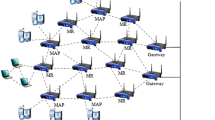Abstract
To solve the challenges of ever-increasing energy consumption, wireless mesh networks (WMNs) consisting of routers using renewable energy sources have been emerging as a promising solution. In this paper, we jointly consider the node placement and energy management in a hybrid WMN consisting of electricity-powered Internet gateways and solar-powered rechargeable routers. We introduce a new metric of failure rate to evaluate network performance and formulate the problem as a constrained optimization problem with the objective of minimizing both capital expenses on installation and operational expenses related to energy consumption. The network Quality of Service (QoS) requirements include meeting the failure rate requirement, the users’ dynamic traffic demand requirements in both downlink and uplink, the gateways’ and routers’ capacity constraints, the maximal transmission power constraints, and the rechargeable routers’ energy consumption constraints. Furthermore, we propose a minimum cost association algorithm to connect mesh clients to the Internet in different slots and a greedy placement algorithm to find approximate solutions for hybrid node placement. Simulation results show that the hybrid placement with rechargeable routers reveals its advantage for large scale networks in terms of more energy saving. Compared with the optimal placement achieved by the exhaustive search, our proposed algorithm can achieve good performance with the significantly reduced computation complexity.















Similar content being viewed by others
References
Guo W, Huang X, Lou W, Liang C (2008) A multi-radio 802.11 mesh network architecture. Mob Netw Appl 13:132–197
Wu W, Luo J, Yang M (2010) Cost-effective placement of mesh nodes in wireless mesh networks. In: IEEE International Conference on Pervasive Computing and Applications (ICPCA), pp 261–266
Amaldi E, Capone A, Cesana M, Filippini I, Malucelli F (2008) Optimization models and methods for planning wireless mesh networks. Elsevier Comput Netw 52(11):2159–2171
Djohara B, Abdelhakim H, Michel G (2008) Wireless mesh networks planning:a multi-objective optimization approach. In: IEEE Broadnets, pp 602–609
Djohara B, Abdelhakim H, Michel G (2009) Optimal placement of gateways in multi-hop wireless mesh networks: a clustering-based approach. In: IEEE Conference on Local Computer Networks, pp 625–632
Djohara B, Abdelhakim H, Michel G, Maureira J (2011) On the design of reliable wireless mesh network infrastructure with qos constraints. Elsevier Comput Netw 5:1631–1647
Farbod A, Todd TD (2007) Resource allocation and outage control for solar-powered wlan mesh networks. IEEE Trans Mob Comput 6(8):960–970
Wang J, Cait K, Agrawal DR (2009) A multi-rate based router placement scheme for wireless mesh networks. In: IEEE International Conference on Mobile Adhoc and Sensor Systems (MASS), pp 100–109
Zhang W, Bai S, XueDharma G, Tang J (2011) Darp: Distance-aware relay placement in WiMAX mesh networks. In: IEEE INFOCOM, pp 2060–2068
Robinson J, Singh M, Swaminathan R, Knightly E (2010) Deploying mesh nodes under non-uniform propagation. In: IEEE INFOCOM, pp 1–9
Franklin A, Murthy CR (2007) Node placement algorithm for deployment of two-tier wmns. In: IEEE Global Telecommunications Conference (Globecom), pp 4823–4827
Gonzalez-Brevis P, Gondzio J, Fan Y, Poor HV, Thompson J, Krikidis I, Chung P (2011) Base station location optimization for minimal energy consumption in wireless networks. In: IEEE Vehicular Technology Conference Spring (VTCSpring), pp 1–5
Shan C, Peng W, Xu Z (2012) Deployment of a connected reinforced backbone network with a limited number of backbone nodes. IEEE Trans Mob Comput 12(6):1188–1200
Boiardi S., Capone A, Sanso B (2012) Energy-aware planning and management of wireless mesh networks. In: IEEE Globecom, pp 3073–3079
Silvia B, Antonio C, Brunilde S (2012) Joint design and management of energy-aware mesh networks. Elsevier Ad Hoc Networks 10(7):1482–1496
Capone A, Malandra F, Sanso B (2011) Energy savings in wireless mesh networks in a time-variable context. Mobile Network and Applications (MONET) Special issue on Future Internet for Green and Pervasive Media, pp 1–14
Jardosh AP, Papagiannaki K, Belding EM, Almeroth KC, Iannaccone G, Vinnakota B (2009) Green wlans: on-demand wlan infrastructures. Springer Mobile Networks and Applications 14(6):798C814
Lin L, Shroff NB, Srikant R (2007) Asymptotically optimal energy-aware routing for multihop wireless networks with renewable energy sources. IEEE Trans Networking 15(5):1021–1034
Li Y, Harms J, Holte R (2006) Traffic-oblivious energy-aware routing for multihop wireless networks. In: IEEE INFOCOM, pp 1–12
Cai LX, Liu Y, Luan TH, Shen(Sherman) X, Mark JW, Poor HV (2011) Adaptive resource management in sustainable energy powered wireless mesh networks. In: IEEE Global Telecommunications Conference (Globecom), pp 1–5
Cai LX, Poor HV, Yongkang L, Tom LH, Xuemin S, Mark JW (2011) Dimensioning network deployment and resource management in green mesh networks. IEEE Wirel Commun 18(5):58–65
Badawy GH, Sayegh AA, Todd TD (2008) Energy aware provisioning in solar powered WLAN mesh networks. In: IEEE globecom workshops, pp 1–5
Zheng Z, Cai LX, Dong M, Shen X, Poor HV (2011) Constrained energy-aware ap placement with rate adaptation in wlan mesh networks. In: Globecom, IEEE Global Telecommunications Conference (Globecom), pp 1–5
Robinson J, Knightly E (2008) A performance study of deployment factors in wmns. In: IEEE international conference on computer communication(INFOCOM)
Pries R, Wamser F, Staehle D, Heck K, Tran-Gia P (2009) On traffic characteristics of a broadband wireless internet access. In: Next generation internet networks, pp 1–7
Sayegh AA, Todd TD, Smadi MN (2008) Resource allocation and cost in hybrid solar/wind powered WLAN mesh nodes, vol 7. Springer, pp 167–189
Author information
Authors and Affiliations
Corresponding author
Additional information
This work is supported by National Natural Science Foundation of China (Grant No: 61371141).
Rights and permissions
About this article
Cite this article
Wang, B., Huan, X., Yang, L.T. et al. Hybrid Placement of Internet Gateways and Rechargeable Routers with Guaranteed QoS for Green Wireless Mesh Networks. Mobile Netw Appl 20, 543–555 (2015). https://doi.org/10.1007/s11036-015-0607-2
Published:
Issue Date:
DOI: https://doi.org/10.1007/s11036-015-0607-2




